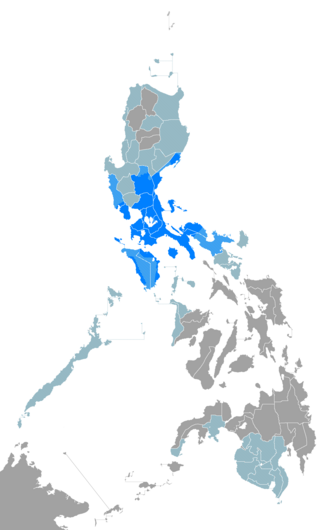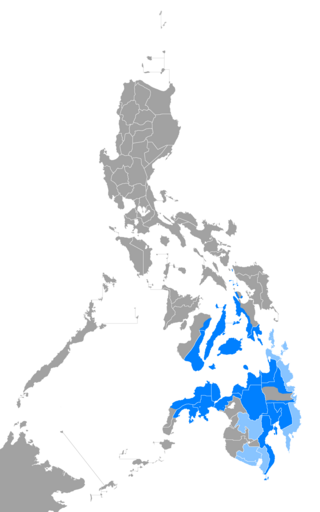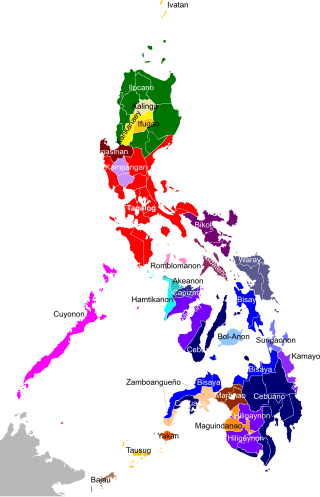
Tagalog is an Austronesian language spoken as a first language by the ethnic Tagalog people, who make up a quarter of the population of the Philippines, and as a second language by the majority. Its standardized form, officially named Filipino, is the national language of the Philippines, and is one of two official languages, alongside English.

Cebuano is an Austronesian language spoken in the southern Philippines. It is natively, though informally, called by its generic term Bisayâ or Binisayâ and sometimes referred to in English sources as Cebuan. It is spoken by the Visayan ethnolinguistic groups native to the islands of Cebu, Bohol, Siquijor, the eastern half of Negros, the western half of Leyte, and the northern coastal areas of Northern Mindanao and the eastern part of Zamboanga del Norte due to Spanish settlements during 18th century. In modern times, it has also spread to the Davao Region, Cotabato, Camiguin, parts of the Dinagat Islands, and the lowland regions of Caraga, often displacing native languages in those areas.

Tagbanwa is one of the scripts indigenous to the Philippines, used by the Tagbanwa and the Palawan people as their ethnic writing system.

Maranao is an Austronesian language spoken by the Maranao people in the provinces of Lanao del Sur and Lanao del Norte and the cities of Marawi and Iligan City in the Philippines, as well as in Sabah, Malaysia. It is a subgroup of the Danao languages of the Moros in the Bangsamoro Autonomous Region in Muslim Mindanao.

The Philippines is inhabited by more than 182 ethnolinguistic groups, many of which are classified as "Indigenous Peoples" under the country's Indigenous Peoples' Rights Act of 1997. Traditionally-Muslim peoples from the southernmost island group of Mindanao are usually categorized together as Moro peoples, whether they are classified as Indigenous peoples or not. About 142 are classified as non-Muslim Indigenous people groups, and about 19 ethnolinguistic groups are classified as neither Indigenous nor Moro. Various migrant groups have also had a significant presence throughout the country's history.

The Tagbanwa people are one of the oldest ethnic groups in the Philippines, and can be mainly found in the central and northern Palawan. Research has shown that the Tagbanwa are possible descendants of the Tabon Man, thus making them one of the original inhabitants of the Philippines. They are a brown-skinned, slim, and straight-haired ethnic group.
The Agutaynen language is spoken on Agutaya Island in the province of Palawan in the Philippines.
The Iraya language is a language spoken by Mangyans on the island of Mindoro in the Philippines. Zorc (1974) places the Iraya language within the North Mangyan group of Malayo-Polynesian languages, though Lobel (2013) notes that it shows "considerable differences" to Tadyawan and Alangan, the other languages in this group. There are 6,000 to 8,000 Iraya speakers, and that number is growing. The language status of Iraya is developing, meaning that this language is being put to use in a strong and healthy manner by its speakers, and it also has its own writing system.
Abellen, Abenlen, Aburlin, or Ayta Abellen, is a Sambalic language. It has about 3,500 speakers and is spoken in a few Aeta communities in Tarlac province, Philippines. Ayta Abellen itself is part of the Sambalic language family in the Philippines and is closely related to not only the five other Ayta dialects but also the Botolan dialect of Sambal. Ethnologue reports 45 monolinguists.

The Sama–Bajaw languages are a well-established group of languages spoken by the Sama-Bajau peoples of the Philippines, Indonesia and Malaysia.
The Palawanic languages are a subgroup in the Greater Central Philippine-family spoken on the island of Palawan and nearby islets.

The Palawan, also known as Palaw'an or Palawano, are an ethnic group native to the Palawan island group in the Philippines. They are the main indigenous population of Palawan. The name of the island they inhabit is named after this ethnic group.
Molbog is an Austronesian language spoken in the Philippines and Sabah, Malaysia. The majority of speakers are concentrated at the southernmost tip of the Philippine province of Palawan, specifically the municipalities of Bataraza and Balabac. Both municipalities are considered as bastions for environmental conservation in the province. The majority of Molbog speakers are Muslims.
Tboli, also Tau Bilil, Tau Bulul or Tagabilil, is an Austronesian language spoken in the southern Philippine island of Mindanao, mainly in the province of South Cotabato but also in the neighboring provinces of Sultan Kudarat and Sarangani. According to the Philippine Census from 2000, close to 100,000 Filipinos identified T'boli or Tagabili as their native language.

The Bukid language, Binukid or Bukidnon, is an Austronesian language spoken by indigenous peoples of Northern Mindanao in the southern Philippines. The word Bukid means 'mountain' or 'highland' while Binukid means 'in the manner, or style, of the mountain or highland'. In Bukidnon province, it is referred to as Higaonon.
Calamian Tagbanwa is spoken in the Calamian Islands just north of Palawan Island, Philippines. It is not mutually intelligible with the other languages of the Tagbanwa people. Ethnologue reports that it is spoken in Busuanga, Coron, Culion, and Linapacan municipalities.
Aborlan Tagbanwa is spoken on Palawan Island in the Philippines. It is not mutually intelligible with the other languages of the Tagbanwa people.
Central Tagbanwa is spoken on Palawan Island in the Philippines. It is not mutually intelligible with the other languages of the Tagbanwa people.

Dupaningan Agta, or Eastern Cagayan Agta, is a language spoken by a semi-nomadic hunter-gatherer Negrito people of Cagayan and Isabela provinces in northern Luzon, Philippines. Its Yaga dialect is only partially intelligible.

Ilocano is an Austronesian language spoken in the Philippines, primarily by Ilocano people and as a lingua franca by the Igorot people and also by the native settlers of Cagayan Valley. It is the third most-spoken native language in the country.












